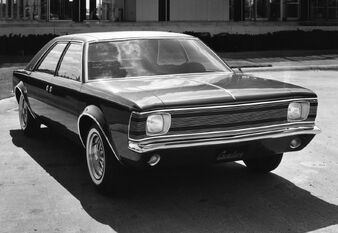
AMC Cavalier - http://www.carstyling.ru
The AMC Cavalier was a concept car built by American Motors (AMC) in 1965. It was innovative by its symmetrical design and use of interchangeable body parts.
Origin[]
The AMC Cavalier was part of three other prototypes that hinted at some of AMC's future production vehicles. In 1966, the Cavalier became part of "Project IV" touring the auto show circuit. This group of four show cars included the Vixen (a four passenger coupe with a "flying buttress" rear roof pillars), the AMX prototype (a two-seat coupe that evolved into the real production car), and the AMX II (a notchback hardtop that was 8 inches (200 mm) longer than the AMX).
Only the four-door Cavalier sedan was designed by Richard A. Teague in AMC's advanced design studio.
Innovation[]
The AMC Cavalier was unique in that it was a study in symmetry.It was built to demonstrate the use of numerous interchangeable body panels. For example, the fenders were identical (the opposite ends, e.g. left front and right rear). The doors were similarly shared with opposite sides, an idea originated by Cord on the prototype 935 Saloon,since the rear doors were hinged in the back (suicide door). The hood and decklid were also interchangeable. The Nash Metropolitan, which was sold by AMC up to 1962, also had interchangeable inner panels, but the outer skin was different. In addition to reducing tooling costs by thirty percent, the design objective of the AMC Cavalier was also to demonstrate how to reduce the costs of production.
The dash was a schematic layout of the car; the Cavalier profile and interior cavities were represented in the design of the dashboard.
The AMC Cavalier featured curved sides, as if a fuselage, punctuated by full wheel arches. The rear roof pillars ("C" pillar) were a "flying buttress" design providing the side view of the car with a sweptback roof to what appears a short rear deck. The rear window was recessed making back area look similar to General Motors' 1966 "A" body platform 2-door models such as the Pontiac GTO.
The AMC Cavalier featured a minimal amount of ornamentation compared to contemporary production cars.
Under the innovative body panel structure, the plan was for a conventional front-mounted 343 cu in (5.6 L) 280 bhp (209 kW) AMC V8 engine with rear-wheel drive (FR layout). The AMC Cavalier had a 108-inch (2,743 mm) wheelbase with a seating capacity for six passengers.The four-door sedan was compact sized, measuring 175 inches (4,445 mm) in overall length, 50 inches (1,270 mm) high, and 65.5 inches (1,664 mm) wide.
Legacy[]
According to Robert B. Evans, chairman of the automaker at the time, the innovative AMC Cavalier toured the auto show circuit to "help restore public confidence in AMC, where sales have sagged."
Except for the short hood giving it equal-length front and rear decks, many of the Cavalier's styling touches found their way into the AMC Hornet that was introduced for the 1970 model year. The Hornet was also designed under the direction of Richard A. Teague.
Postage stamp[]
The Sharjah Post Office issued an airmail stamp in 1970 depicting a drawing of an AMC Cavalier. It is part of a "Post Day" series illustrating a pair of early and modern automobiles. The postage stamp shows a 1904 Rambler and a 1965 Cavalier (this is identified as a 1970 model probably because the show car looked so similar to the AMC Hornet that was introduced that year).
Name[]
American Motors planned to use the "Cavalier" name for a new pony car model to debut in 1968. By that time, however, General Motors had secured the rights to the "Cavalier" name. The second choice was selected: Javelin.
